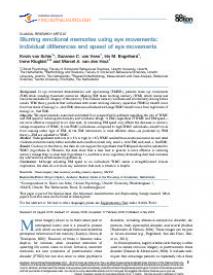Blurring emotional memories using eye movements : individual differences and speed of eye movements
Background: In eye movement desensitization and reprocessing (EMDR), patients make eye movements (EM) while recalling traumatic memories. Making EM taxes working memory (WM), which leaves less resources available for imagery of the memory. This reduces memory vividness and emotionality during future recalls. WM theory predicts that individuals with small working memory capacities (WMCs) benefit more from low levels of taxing (i.e., slow EM) whereas individuals with large WMC benefit more from high levels of taxing (i.e., fast EM).
Objective: We experimentally examined and tested four prespecified hypotheses regarding the role of WMC and EM speed in reducing emotionality and vividness ratings: 1) EM—regardless of WMC and EM speed—are more effective compared to no dual task, 2) increasing EM speed only affects the decrease in memory ratings irrespective of WMC, 3) low-WMC individuals—compared to high-WMC individuals—benefit more from making either type of EM, 4) the EM intervention is most effective when—as predicted by WM theory—EM are adjusted to WMC.
Method: Undergraduates with low (n=31) or high (n=35) WMC recalled three emotional memories and rated vividness and emotionality before and after each condition (recall only, recall + slow EM, and recall + fast EM).
Results: Contrary to the theory, the data do not support the hypothesis that EM speed should be adjusted to WMC (hypothesis 4). However, the data show that a dual task in general is more effective in reducing memory ratings than no dual task (hypothesis 1), and that a more cognitively demanding dual task increases the intervention’s effectiveness (hypothesis 2).
Conclusions: Although adjusting EM speed to an individual’s WMC seems a straightforward clinical implication, the data do not show any indication that such a titration is helpful.
In: European journal of psychotraumatology, ISSN 2000-8066 | 7 | 1 | 29476
http://dx.doi.org/10.3402/ejpt.v7.29476


